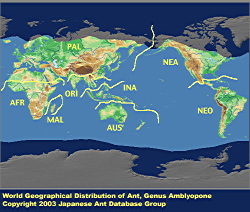
|
genus
|
Amblyopone
|
 |
Japanese Name
|
Nokogiri-hariari-zoku
|
Original Reference
|
|
Erichson, W.F. (1842) Beitrag zur Insecten-Fauna von Vandiemensland, mit besonderer BerYNcksichtigung der geographischen Verbreitung der Insecten. Archiv fYNr Naturgeschichte 8: 83-287.
|
Synonym
|
|
Stigmatomma Roger, 1859,
Neoamblyopone Wheeler, W. M., 1927,
Protamblyopone Wheeler, W. M., 1927,
Artropus Provancher, 1881,
Ericapelta Kusnezov, 1955,
Lithomyrmex Clark, 1928,
Amblyopopona Schulz, 1906,
Amblyopopone Dalla Torre, 1893
|
Description
|
|
Total length of workers ranging from around 1 to 10 mm. Eyes reduced. Petiole attached broadly to gaster. Mandibles slender and long; internal margins with teeth or denticles set in one or two rows. Anterior clypeal margin usually with a number of denticles (sometimes only several) arranged in a transverse row. Antennae 7, 10, 11 or 12 segmented.
|
|

|
Remarks
|
|
Amblyopone species are usually active beneath the ground. They nest in rotting logs and other fallen decaying wood, rotting stumps, or in the soil, sometimes under stones. They prey upon subterranean arthropods (in some cases especially on geophilid centipedes), or those resident in rotting wood. The genus is widely distributed globally, except for the arctic and Antarctic zones. There are about 60 described species, and a number of undescribed forms are known in collections. Four species are present in Japan: A. caliginosa Onoyama, A. fulvida Terayama, A. sakaii Terayama, and A. silvestrii (Wheeler). Japanese collection records for species other than A. silvestrii are scarce.
|
References
|
|
- Roger, J. 1859. Beitr?ge zur Kenntniss der Ameisenfauna der Mittelmeerl?nder. I. Berl. Entomol. Z., 3: 225-259.
- Wheeler, W. M. 1927. Ants of the genus Amblyopone Erichson. Proc. Am. Acad. Arts Sci., 62: 1-29.
- Brown, W. L., Jr. 1949. A new American Amblyopone, with notes on the genus (Hymenoptera: Formicidae). Psyche, 56: 81-88.
- Brown, W. L., Jr. 1960. Contributions toward a reclassification of the Formicidae. III. Tribe Amblyoponini (Hymenoptera). Bull. Mus. Comp. Zool., 122: 143-230.
- Provancher, L. 1881. Faune canadienne. Les insectes?\Hym?nopt?res. Naturaliste Canadien, 12: 193-207.
- Provancher, L. 1887. Fam. 10?\Les Formicides (pp. 224-249). In Additions et Corrections au Volume 2 de la Faune Entomologique du Canada, traitant des Hym?nopt?res, 477 pp. Qu?bec.
- Kusnezov, N. 1955. Zwei neue Ameisengattungen aus Tucuman (Argentinien). Zool. Anz., 154: 268-277.
- Clark, J. 1928. Australian Formicidae. J. R. Soc. West. Aust., 14: 29-41.
- Schulz, W. A., 1906. Spolia hymenopterologica. 355 pp. Junfermannsche Buchhandlung, Paderborn.
- Bolton, B. (1994). Identification guide to the ant genera of the world. Harvard University Press, 222 pp.
|
Editor
|
|
Original text by Keiichi Onoyama. Revised by Masashi Yoshimura. English translation by Keiichi Onoyama, edited by Robert W. Taylor.
|
|